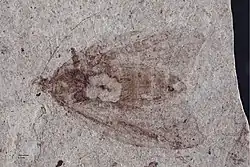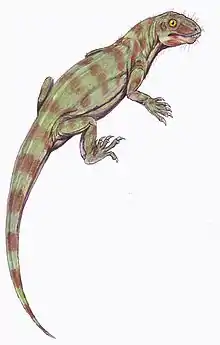1907 in paleontology
Paleontology or palaeontology is the study of prehistoric life forms on Earth through the examination of plant and animal fossils.[1] This includes the study of body fossils, tracks (ichnites), burrows, cast-off parts, fossilised feces (coprolites), palynomorphs and chemical residues. Because humans have encountered fossils for millennia, paleontology has a long history both before and after becoming formalized as a science. This article records significant discoveries and events related to paleontology that occurred or were published in the year 1907.
| |||
|---|---|---|---|
| +... |
Plants
Ferns and fern allies
| Name | Novelty | Status | Authors | Age | Type locality | Location | Notes | Images |
|---|---|---|---|---|---|---|---|---|
|
Cladophlebis skagitensis[2] |
Sp nov |
A Cladophlebis pinnule |
||||||
|
Nilsonia pasaytensis[2] |
Sp nov |
A Nilsonia foliage |
||||||
Conifers
| Name | Novelty | Status | Authors | Age | Type locality | Location | Notes | Images |
|---|---|---|---|---|---|---|---|---|
|
Picea columbiensis[2] |
Sp nov |
valid |
Kettle River Formation? |
A cone and foliage Spruce species. |
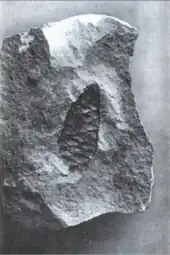 Picea columbiensis | |||
|
Pinus columbiana[2] |
Sp nov |
Kettle River Formation? |
A wood and cone pine species. |
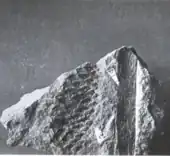 Pinus columbiana | ||||
Flowering plants
| Name | Novelty | Status | Authors | Age | Type locality | Location | Notes | Images |
|---|---|---|---|---|---|---|---|---|
|
Myrica serrata[2] |
Sp nov |
A Myrica? foliage |
||||||
|
Ulmus columbiana[2] |
Sp nov |
jr synonym |
Kettle River Formation? |
An elm wood species. |
_Plate8_Fig1.png.webp) Ulminium columbianum | |||
|
Ulmus protoamericana[2] |
Sp nov |
Kettle River Formation? |
An elm wood species. |
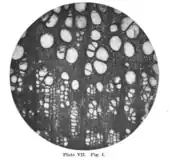 Ulmus protoamericana | ||||
|
Ulmus protoracemosa[2] |
Sp nov |
Kettle River Formation? |
An elm wood species. |
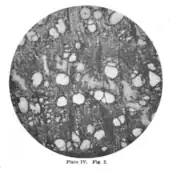 Ulmus protoracemosa | ||||
Arthropods
Insects
| Name | Novelty | Status | Authors | Age | Type locality | Location | Notes | Images |
|---|---|---|---|---|---|---|---|---|
|
Megaraphidia[5] |
Gen et Sp nov |
valid |
A raphidiid snakefly |
_NPS_img1.jpg.webp) Megaraphidia elegans | ||||
|
sp. nov |
jr synonym |
A moth of uncertain placement, |
| |||||
Archosaurs
- Wieland claims to have found stegosaur gastroliths.[10]
- Brown argues that Wieland's alleged stegosaur gastroliths were "not associated with the stegosaur bones in question."[11]
- Possible hadrosaur gastroliths documented.[11]
Newly named ornithodirans
Data courtesy of George Olshevsky's dinosaur genera list.[12]
| Name | Novelty | Status | Authors | Age | Unit | Location | Notes | Images |
|---|---|---|---|---|---|---|---|---|
| Scleromochlus[13] |
gen. et sp. nov |
Valid |
|
A member of Ornithodira. |
||||
Synapsids
Non-mammalian
| Name | Novelty | Status | Authors | Age | Unit | Location | Notes | Images |
|---|---|---|---|---|---|---|---|---|
|
Gen. et. sp. nov |
Valid |
Broom |
A member of Lycideopsidae. |
| ||||
|
Gen. et sp. nov |
Valid |
Broom |
A member of Galeopidae. | |||||
References
- Gini-Newman, Garfield; Graham, Elizabeth (2001). Echoes from the past: world history to the 16th century. Toronto: McGraw-Hill Ryerson Ltd. ISBN 9780070887398. OCLC 46769716.
- Penhallow, D. P. (1907). "A report on fossil plants from the International Boundary Survey for 1903–1905, collected by Dr. R A Daly.". Proceedings and Transactions of the Royal Society of Canada. 3. Vol. 1 (sect 4). Royal Society of Canada. pp. 287–351.
- Höy, T.; Friedman, R.; Gabites, J. Paleogene Penticton Group, Boundary area, Southern British Columbia (Parts of NTS 082E): Geochronology and Implications for Precious Metal Mineralization (PDF) (Report). Geoscience BC Summary of Activities 2020: Minerals, Geoscience BC, Report 2021-01. Geoscience BC. pp. 55–66.
- Edwards, W. N. (1931). Jongmans, W. (ed.). Fossilium Catalogus. II. Plantae. Pars 17. Dicotyledones (Ligna). Berlin.
{{cite book}}: CS1 maint: location missing publisher (link) - Cockerell, T. (1909). "Some fossil arthropods from Florissant, Colorado". Bulletin of the American Museum of Natural History. 23: 605–616.
- Carpenter, F.M. (1936). "Revision of the Nearctic Raphidiodea (Recent and Fossil)". Proceedings of the American Academy of Arts and Sciences. 89 (2): 89–158. doi:10.2307/20023217. JSTOR 20023217.
- Makarkin, V.; Archibald, S. (2014). "A revision of the late Eocene snakeflies (Raphidioptera) of the Florissant Formation, Colorado, with special reference to the wing venation of the Raphidiomorpha". Zootaxa. 3784 (4): 401–444. doi:10.11646/zootaxa.3784.4.4. PMID 24872063.
- Cockerell, T. D. A. (1907). "A fossil tortricid moth". Canadian Entomologist. 39 (12): 416. doi:10.4039/ent39416-12. S2CID 85726085.
- Maria Heikkilä; John W. Brown; Joaquin Baixeras; Wolfram Mey; Mikhail V. Kozlov (2018). "Re-examining the rare and the lost: a review of fossil Tortricidae (Lepidoptera)". Zootaxa. 4394 (1): 41–60. doi:10.11646/zootaxa.4394.1.2. PMID 29690381.
- Wieland (1907). Sanders, Manley, and Carpenter (2001), "Table 12.1" page 167.
- Brown (1907). Sanders, Manley, and Carpenter (2001), "Table 12.1" page 167.
- Olshevsky, George. "Dinogeorge's Dinosaur Genera List". Archived from the original on 2011-07-15. Retrieved 2008-08-07.
- Woodward, A.S. 1907. On a new dinosaurian reptile (Scleromochlus taylori, gen. et sp. nov.) from the Trias of Lossiemouth, Elgin. Quart. J. Geol. Soc. London 63 (1, article 10): pp. 140-144.
- Brown, B. (1907). Gastroliths, Science, 25(636), p392.
- Sanders F, Manley K, Carpenter K. Gastroliths from the Lower Cretaceous sauropod Cedarosaurus weiskopfae. In: Tanke D.H, Carpenter K, editors. Mesozoic vertebrate life: new research inspired by the paleontology of Philip J. Currie. Indiana University Press; Bloomington, IN: 2001. pp. 166–180.
- Wieland, G.R. (1907). Gastroliths. Science, 628:66-67.
